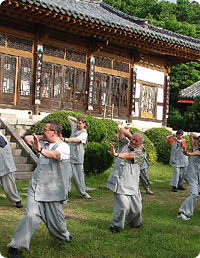SPECIAL INTEREST
Catholic Pilgrim (B) 11 days
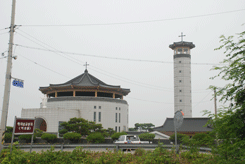
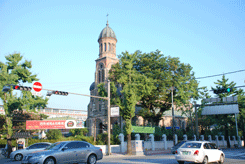
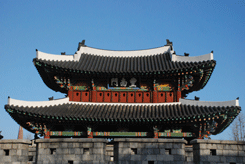
Tour Highlights
- Myeongdong Cathedral
- Saenamteo Holy Ground
- Jeoldusan Beheading Hill
- Gyeongbokgung Palace
- National Folk Museum of Korea
- Insadong
- Namdaemun Market
- Cheonjinam holy ground
- Baeron holy ground
- Yeonpung holy ground
- Hahoemaeul Village
- Seokguram Grotto
- Bulguksa temple
- Gyeongju National Museum
- Cheomseongdae Astronomical Observatory
- Tumuli Park
- Oryundae Martyr Memorial
- Jagalchi Fish Market
- Okbong Catholic Church
- Gokseong Catholic Church
- Naju Catholic Church
- Jeongdong Catholic Church
- Jeonju Hanok Village
- Buyeo National Museum
- Jeongrimsa Pagoda
- Galmaemot holy ground
- Hongju holy ground
- Haemi Fortress
- Yeosutgol holy ground
- Solmoe Holy Ground
- Mirinae holy ground
- Hwaseong Fortress
Click on the days to access the programs quick
| Days | Visits and Activities | Distance |
| Day 1 | Arrive Seoul | 60km |
| Day 2 | Seoul | |
| Day 3 | Seoul - Gwangju - Jaecheon - Yeonpung - Suanbo | 260km |
| Day 4 | Suanbo - Andong - Gyeongju | 250km |
| Day 5 | Gyeongju | |
| Day 6 | Gyeongju - Busan | 110km |
| Day 7 | Busan - Jinju - Gokseong - Gwangju | 340km |
| Day 8 | Gwangju - Jeonju - Buyeo | 180km |
| Day 9 | Buyeo - Boryeong - Haemi - Dangjin - Anseong - Suwon | 280km |
| Day 10 | Suwon - Seoul | 50km |
| Day 11 | Departure | 60km |
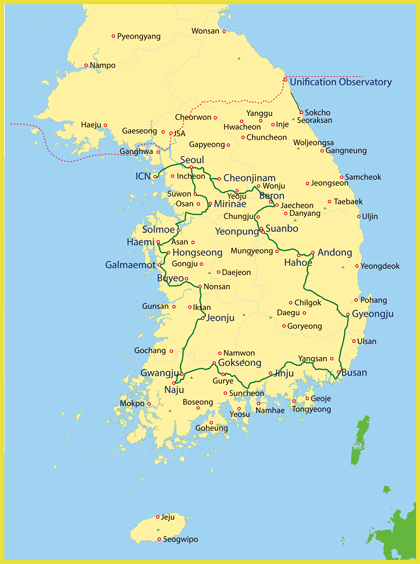 Day 1 Arrive Seoul (- - -)
Day 1 Arrive Seoul (- - -)
60km
Touching down at Incheon International Airport places you in the heart of Korea. After you clear Passport and Customs control, you will be welcomed by the tour guide and then transferred to your hotel.
Day 2 Seoul (B)
Catholicism had a bloody beginning in Korea, as its early years were marked by persecution and martyrdom. In 1882, tacit consent was given to the freedom of religion for Catholics and this freedom was officially recognized in 1895. Since then the Catholic Church in Korea had the opportunity to serve Korean people and society. The Korean Church is unique because it was founded entirely by lay people.
Your spiritual journey in Korea begins with a visit to Myeongdong Cathedral, the birthplace of Catholicism in this country and holds the remains of martyrs who gave their lives to realize their religious beliefs. It is the Korea's first Gothic building and an important milestone in the country's architectural history.
Saenamteo is in proximity to the Han River used to serve as the training ground for soldiers from early Joseon period. It is also where those found guilty of heavy crimes were executed. In 1456, the six administrators who remained loyal to the dethroned king were executed. It was also a persecution ground for Catholics, where many followers were put to death in 1801, 1839, 1846 and 1866 following major crackdowns against the religion.
11 religious leaders including Korea's first priest Kim Daegeon, the first Chinese priest to enter Korea Zhou Wen Mo, the first foreign bishop to visit Korea, the French Imbert were martyred here as well as many followers. Today there is a cathedral commemorating the 200 years history of Catholicism in Korea.
Jeoldusan is a spot near a cliff along the Han River. When French navy ships sailed up the Han River in February 1866 to protest the Catholic persecution, the enraged ruler Daewongun ordered the beheading of a mass of followers. The execution took place in Jamdubong hill which was henceforth known as Jeoldusan, or beheading mountain. The Korean Catholic church opened a memorial in October 1967 in tribute to the martyrs 100 years ago. The memorial in Jeoldusan today holds historic materials on the religion in Korea, articles once belonging to the dead, as well as the 28 remains of martyrs, a pilgrim church, education hall and an outdoor exhibition space. In 1996, a church was built in remembrance of the martyrs. Here you will find a statue of Father Kim Daegeon, Korea's first catholic priest who was martyred September 15th 1846 in Saenamteo. Pope John Paul II paid a visit to this church when he came to Korea for the canonization mass for 103 martyrs on May 6th 1984.
Drive past Gwanghwamun Plaza where Pope Francis celebrated Mass to beatify 124 Korean martyrs on August 16, 2014.
Step back in time to when life was gracefully slow and discover Gyeongbokgung Palace, a particularly charming spot that represents a colorful and turbulent side of the capital's 500-year history. Depending on timing, you may witness the Royal Guard Changing Ceremony featuring parade, password verification, duty shift and patrolling the gate. Accompanied by a court band with its colorful costumes and royal flags, the ceremony is performed daily basis at 10:00 and 14:00 except Tuesdays, although it is cancelled in case of rain or extremely hot or cold weather.
Your visit to the National Folk Museum of Korea will familiarize you with wealthy culture of this friendly and picturesque nation. It is an excellent facility to illustrate the history of traditional life of the Korean people from the prehistoric age to the Joseon dynasty. The permanent exhibition features life and work, costumes and ornaments, handicrafts and technology, educations, living quarters, dietary life, oriental medicine, performing arts and games, beliefs and rituals, and
socio cultural life.
Insadong, at one time the center of traditional Korean art and antiques, features a mixture of historical and modern atmosphere representing the cultural glimpse of the nation. Clustered along the main street and alleys are lined with street vendors, wooden tea houses, restaurants and numerous galleries and shops dealing in antiques, oriental art supplies, and modern Korean art of all types and styles. Soak in the paintings, upscale artworks, antiques and potteries while you can. Get lucky and you just might meet the artist themselves. It can be plenty of fun walking on the main street, but you venture into the hidden alleys that do spring some unexpected surprises. While here, you may want to buy some souvenirs or simply wander and browse at leisure admiring cultural ambience.
You will tour the centuries-old Namdaemun Market brimming with well over 11,000 shops selling anything you can imagine. One of the most colorful aspects of the market is an endless sprawl of street-vendor stalls that setup in the alleys and walkways between the buildings. The market is seriously crowded, so be prepared to get bumped around. A fantastic place to haggle over the price to get the best deal on something you want or simply admire the vibrancy of this massive market.
At the western entrance of the market in the middle of a traffic circle stands Sungnyemun. It is a formidable and iconic construct that served as the southern gate of the wall that surrounded Seoul during the period of the Joseon Dynasty.
Day 3 Seoul - Gwangju - Yeonpung - Suanbo (B) 260Km
Your pilgrim begins with a visit to Cheonjinam where Korean Catholicism was born. Historic records and headstone scripts attest to the place's significance as the Catholic origin of Korea. It is where Lee Byeok, profoundly moved by Matteo Ricci's De Deo Verax Disputatio, turned a study group into a religious gathering in 1779. He also urged Lee Seunghun to be baptized in Beijing, which he did in 1784. Upon his return in the autumn of 1784 with religious books, medals, statues and other holy materials, he in turn baptized Lee Byeok who went on an active proselytizing campaign. His efforts soon drew pressure and threats from the society and the courts, and Lee was soon placed under house arrest. During this time he refused to drink or eat or even change clothes, devoting himself wholly to praying and meditating on Catholicism. But fifteen days of fasting and meditation completely drained him and he passed away on June 14, 1785 (lunar calendar) at the age of 32. He remained true to his faith until his last moment. It is a permanent home of the five founding members Jeong Yakyong, Lee Byeok, Gwon Cheolshin, Gwon Ilshin and Lee Seunghun.
Baeron holy ground has great spiritual significance to the spread of Catholicism in Korea. The faith pioneers had been gathering in hide to keep their faith under the harsh wind of persecution. Amid the persecution in 1801, Hwang Sayeong (Alexander, 1775–1801), an early Korean Catholic leader wrote to the Most Rev. Alexandre de Gouvea, Bishop of Beijing, expounding the serious situation of the Catholics in Joseon. But due to the betrayal of the messenger, his letter never delivered. Mr. Hwang and his fellow faithful were arrested and executed outside of Seosomun, Seoul. It was Baeron that St. Joseph Theological School was established in 1855, which was the foundation of the Catholic University of Korea. Baeron is a permanent home to Thomas Choe Yangeop (1821–1861), Korea’s second Roman Catholic priest.
Visit
Yeonpung Martyrs Shrine and earn about an early settlement of Catholics and persecutions. Yeonpung was known for being hard to reach from other areas, the faithful went into hiding to keep their faith. Yeonpung is a home of Martyr Hwang Sukdoo, Lucas who performed his duties as a catechist admirably. He finally became an assistant to Bishop Berneux and Bishop Daveluy. He wrote many books with Bishop Berneux. When Bishop Daveluy was arrested, Lucas insisted on being arrested with the bishop. They were all sent to Seoul. In prison Catechist Lucas preached the Catholic religion to his prosecutors, who admired his knowledge and eloquence. On March 30, 1866, Lucas was beheaded at Kalmaemot following Bishop Daveluy, Pierre Aumaître, Martin Luc Huin and Jang Jugi Joseph.
Day 4. Suanbo - Andong - Gyeongju (B) 250Km
Andong is a stronghold of Confucianism in Korea that has deeply influenced the lives of Koreans in all aspects. You will explore UNESCO World Heritage Site, Hahoemaeul from the 15th century. It is the best preserved traditional village portraying and spanning the life of the Joseon Dynasty (1392-1910) and some 480 Korean traditional houses, both large and small, are still fully functioning. As you take a walk in the narrow alleys, enjoy the rustic and old charm of this unique village. You cannot possibly miss a 600-years old zelkova tree, the home to the village spirit. At the tree's base is where residents still make their wishes. The village is also known for traditional festival, Hahoe Mask Dance which gave common people the opportunity to mock those in authority, and in particular the Byeolsingut, a shaman ritual exorcising evil spirits, dating back to the Goryeo dynasty (918-1392).
Travel to Gyeongju, an ancient capital of Silla (BC57-AD935), often dubbed as Museum without Walls. Today, you are treated to one of the ten most historically significant sites in the world with ancient temples, weathered stone pagodas, royal tombs, Buddhist bas-reliefs, and fortress ruins. The Gyeongju Historic Areas contain a remarkable concentration of outstanding examples of Korean Buddhist art, in the form of sculptures, reliefs, pagodas, and the remains of temples and palaces from the flowering, in particular between the 7th and 10th centuries, of this form of unique artistic expression.
Day 5 Gyeongju (B)
With a full day to further explore the delights of UNESCO World Heritage Site, Seokguram grotto. It is the home of the serene stone Buddha of the eighth century. Inside, a white statue of a seated Buddha in a sublime state of enlightenment, is surrounded by 37 relief figures of Bodhisattvas, disciples, devas, and guardian kings. The grotto represents the magnificent harmony of religion, science and the arts of Buddhism, symbolizing the pure land in which Buddha resides.
A short ride leads you to another UNESCO World Heritage Site, Bulguksa temple, where you will witness the impressive gates, symbolic bridges leading up to the world of Buddha, graceful architectures, Three-storied Seokgatap and highly ornate Dabotap blending well into the architectural harmony.
At Gwaneumjeon hall, check out the image of the Avalokitesvara who is referred to as the Bodhisattva of Compassion and has a thousand hands, and eyes in each so as to reach out to those in need of help. You will see a gilded statue of Vairocana with the gesture of the first wisdom, Sakyamuni Buddha along with sixteen figures of Buddha's disciples sitting in deep meditation, and a gilt-bronze Amitabha Buddha who is the ruler of the Western Paradise Sukhavati. The architectural design of Bulguksa is one of constrained dignity, peace, and harmony and the temple still remains one of the most remarkable achievements of the ancient Far East.
Next up is Gyeongju National Museum. The first thing that you will notice is The Bell of King Seongdeok, the largest extant bell in Korea. You must certainly stand in awe before the bell from the 8th century with such artistic beauty of design. The bell is distinguished not only for its outstanding beauty but also for its long reverberating sound, the incredibly precise casting technique, in addition to the sad legend surrounding it. On entering the museum, you will marvel at the priceless archaeological and historical artifacts including splendid gold crowns, earrings, belts, ornaments, glassware, potteries, and clay figures as well as a royal barge.
Afterwards, explore Donggung palace and Wolji pond, a pleasure garden built to commemorate the victory of Silla, and later used as the recreational area for the Silla's royal family.
Check out the world's oldest existing astronomical observatory, Cheomseongdae. Each stone used in the observatory bears symbolic meaning; the same number of the days of the year by lunar calendar, the number of the major stars, the months of the year and the numbers of the seasonal divisions. Nearby Tumuli Park encompasses 23 huge tomb mounds where Silla rulers were buried. One of the tombs, Cheonmachong, is opened to the public and you can go inside and see how the tombs were made and replicas of the treasures excavated in 1973.
With time to visit, stroll down the alleys of downtown Gyeongju admiring ancient charm blending well with modern culture. You will also explore Seongdong market close to the Gyeongju train station, where you will see a classic example of the Korean market with lots of fresh vegetables, seafood, food stands and some textiles. The market spills out on to the street and local vendors, many elderly women sell home-grown vegetables and grains.
Day 6 Gyeongju - Busan (B) 110km
Busan is Korea's second largest city surrounded by the ocean on one side, and mountains on the other. Its deep harbor and gentle tides have allowed it to grow into the largest port in Korea and the fifth largest in the world. It is also a center of industry and commerce, a thriving metropolis formed unusually long in shape along its coastal line.
Visit Oryundae Martyrs Shrine, an excellent facility featuing Catholic history in Korea, Martyrdom, relics and persecursions. A small boat is on display in front of the Martyr's Cathedral next to the museum. This replica boat of half scale, named 'Raphael', was a kind of one used by Father Andrea, St. Kim Daegeon Kim, the first priest in Korea, the priest Ferreol and the priest Daveluy on their way from Shanghai, China. There is a graveyard of 8 martyrs executed in 1868.
You will tour Yongdusan Park where Busan Tower sits atop a hillock of a steep slope, affording 360-degree views of the hilly terrain of this mountainous coastal city and the harbor. Smack dab in the middle of the park stands the statue of Yi Sunsin, who is credited with the perfection of the first iron-clad warship in history. You will also see a flower clock and a Busan citizen's bell that they ring on New Years' Day, March 1 and August 15.
Just off the park is Gwangbokro Street, full of shops selling everything from bargains to luxury items. Adjacent is a maze of small streets alive with color, sidewalks sprinkled with unique shops and local eateries. Enjoy the vibrant ambience as you leisurely make your way to the BIFF square, Busan’s modern movie district having hand prints of the famous movie stars and directors on the sidewalk, movie theaters, trendy shops and street food stalls. The area with originally little more than a pair of cinemas that were built over half a century ago had turned into the newly transformed district, and was named BIFF Square on August 14, 1996.
Across the street from the square is a fascinating Jagalchi fish market, a great attraction located dockside. Here you will find a diverse array of seafood on display as you walk along the narrow alleys of street vendors. A nearby indoor market features live fish in the tanks and the upstairs are dried fish along with many restaurants selling raw fish at reasonable prices. The market is really a visual and culinary treat.
Later, explore Gamcheon village is an amazing community built on the side of a hill. Once a poverty-stricken village, it has been spruced up with colorful houses, cafes, murals, galleries and arts shops, sculptures, and scenic views. The atmosphere feels more fun, creative and quirky, less commercial and mercenary. The attraction weaves in and out of back alleys where people still live. It is out of the way, but relatively easy to get to. The artistic vibes in the village in light of its history makes it a culturally distinctive place in an urban city. You can take winding alleys and stairs that form a maze around and through and freely walk up and down hills taking in the views and the culture.
Day 7 Busan - Jinju - Gokseong - Gwangju (B) 340km
Okbong Catholic church served as an Catholic center affiliated with Masan Cathedral, which is located outside of Jinju. The history of the Church begins in 1911 with the establishment of the Okbong chapel-of-ease under the jurisdiction of the Masan Catholic Church. After having acquired the status of a parish church in 1926, the current red brick church building was constructed in 1933 and It has been expanded multiple times.
As its congregation steadily grew over time, the church was repeatedly expanded and repaired, resulting in its present form which differs from the original building. In the front, the church features a rectangular bell tower with a spire,
and the windows on the sides of the building were fitted with stained glass in the 1990s. This illustrates the gradual change of the original neo-Gothic design.
Gokseong is the epicenter of the Jeonghae Persecution in 1827, resulted from a strife at the Deoksil village.
The persecutions lasted 2 months, but many hundereds of the faith were arrested, but most of them apostatized due to severe supression.
However, Magdalena, Lee Seongji, Lee Seongsam, and Lee Gyeongeon kept their faith. On the site of the jail stands Gokseong Catholic church.
Day 8 Gwanju - Jeonju - Buyeo (B) 180Km
Jeonju is a time-honored tradition as well as significant cultural and artistic heritage. There's a plenty of history and artifacts of many kinds to go around. You will explore Jeonju Hankok village, a Korean House complex retaining much of their perfection intact. Near the entrance of the complex stands a beautiful Jeondong Catholic church of Byzantine and Romanesque architectural design. Completed in 1914, it is one of the oldest and largest Western-style buildings in the region. It was designed by master church builder Victor Lousi Poisnel, the Norman priest whose work in Korea includes Myeongdong Cathedral in Seoul. Just west of the church is the stately Pungnammun gate, where two Catholics, Yun Jichung and Gwan Sangyeon paid for their religion with martyrdom on December 8, 1791, marking the first time in Korea.
Buyeo is a melting pot of Baekje culture which is often regarded as the most artistically sophisticated of the Three Kingdoms. Today, you will explore archaeological sites and ancient historic areas, which were collectively named as a UNESCO World Heritage sites. Jeongrimsa temple site with its five-storied stone pagoda recalling the glorious past is one of the city's most distinctive and outstanding landmarks.
At Buyeo National Museum, you will feel the spirit and the essence of the brilliant Baekje culture as you appreciate the beauty of the archaeological relics. A beautiful gilt bronze incense burner is impossible to miss. Crafted over 1,500 years ago, it shows a graceful dignity and the elaborate skills of Baekje craftsmen.
Day 9 Buyeo - Boryeong - Haemi - Dangjiin - Anseong - Suwon (B) 280km
The pilgrim today is fairly packed. You will begin your day by paying a visit to Galmaemot holy ground. The five Catholics were decapitated on Good Friday, March 30, 1866; bishop, priests and laity together marching on to God, bleeding. There were many anonymous victims in the persecution period other than the five martyrs listed in the diary of the executed and the five canonized saint martyrs. The name 'Galmaemot' refers to a pond where thirsty horses drank water from. The spiritually thirsty people rather than horses come here to quench their thirst. The depth of the pond is as deep as the pain of the history. The martyrs' religious faith and love filled the pond as a form of essential water of life.
Hongju Holy Ground where 212 martyrs were executed. They willingly embraced Catholicism as they were moved by its religious doctrine that stresses equality before God. Many followers kept their faith while in prison, despite torture and executions. There is a well-organized pilgrimage route, leading to the Hongju Martyrdom Holy Grounds, including the burial grounds and a place where many martyrs were executed.
Haemi Fortress and Haemi Martyrdom holy ground - Haemi fortress has been the military base since 1491. Architecture aside, Haemi Fortress's historical importance is closely tied with the history of the Catholic Church in Korea. Catholicism flourished in the area and among the many sacred places of South Chungcheong Province, Haemi, formerly Naepo, was the only location that had an army outpost. It was a strategic military point with a fortress. The Haemi governor had the power to execute people in the name of defending the coast.
The area just outside the Haemi fortress's west gate, Yeosutgol, was used as an execution ground ever since the 1790s. Over 1,000 Catholics were buried alive, drowned and otherwise made dead en masse between 1866 and 1868. The rock to the right of the memorial is particularly macabre - some of the victims were executed by ramming their heads repeatedly into the stone. When the execution ground was overcrowded, Catholic believers, with their hands tied, were pushed into in a pond. The pond is long gone, but the site still remains in the Haemi Martyrdom holy ground. Many bones have been found here, and there are also the teeth of many children. A memorial in the Haemi complex has the remains on display. There is a memorial dedicated to those who martyred here. Pope Francis will visit the Haemi Martyrdom Holy Ground and pay his respects at the tombs of the martyrs before celebrating Mass during the Asia Youth Day festival, to be held in the Haemi fortress on August 17, 2014.
Visit Solmoe holy ground is the birthplace of St. Andrew Kim Daegeon (1821-1846), the first Korean Catholic priest, and where the Catholic religion took root in Korea. Four generations of the Kim family, all of whom were martyred, were born and lived here. The house stands down by the pine hill and you will see the statue of Pope Francis praying. The Path of the Cross features a mosaic path showing the hands of Jesus and a bronze path on a large scale. A walk up the pine tree road leads to a bronze statue of the priest holding a bible in his left hand and delivering the message of the Gospel. Nearby is the Path of the Cross, symbolizing the path of the ordeal that Jesus had to walk carrying a cross to his crucifixion as detailed in the Christian Bible.
The Solmoe Holy Ground memorial hall has on display various documents on the life of Priest Kim Daegeon, detailing the persecution of members of the Korean Catholic Church, and letters and reports on martyrs written by the priest. The Path of the Cross features a mosaic path showing the hands of Jesus and a bronze path on a large scale. This is where many Catholic pilgrims pray or meditate while walking among pine trees. This Holy Ground is of major significance as one of the sites Pope Francis visited during his official visit to Korea. The papal trip is all the more momentous as it is his first visit to Asia and he will only be visiting Korea.
Mirinae is the place where the faithful gathered together and created a community at the time of harshest persecution in 1801 and 1839. At the entrance of Mirinae is a magnificent cathedral built in commemoration of the canonization of 103 saints. Behind the church building features a series of bronze statues that chronicle the tribulations of Jesus from his capture by the Roman soldiers to crucifixion and entombment. You will also see the grave site of martyr Kim Daegeon, and a hall holding father Kim's remains and the Gethsemane hill.
Day 10 Suwon - Seoul (B) 50Km
Explore UNESCO World Heritage site of Hwaseong Fortress from the 18th century. Though it is relatively small in scale, it is well acknowledged as the best structure of its kind ever built in Korea. A 5.74km-long fortress enclosing both flatland and hilly terrain is parapeted with crenels and merlons and highlighted by four main gates and well over 50 structures including temporary palace where the king sought refuge during war and found rest during times of peace. A walk through the whole fortress could take several hours but it is well worth making a short walking tour to enjoy the splendor of the fortress, including the Korea's largest Janganmun Gate.
On arrival at Seoul, check in and balance of the day at leisure. You will explore the city yourself or look for souvenirs.
Day 11 Departure (B) 60km
After this wonderful trip exploring Korea and with time to reflect on your surprise in your experience, you will return to the airport in time for your flight. By boarding, you are already high above Incheon heading for home.





